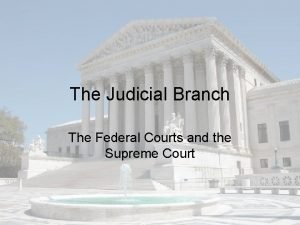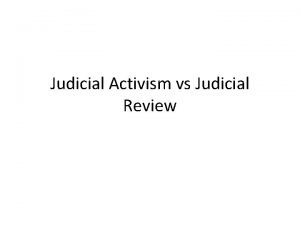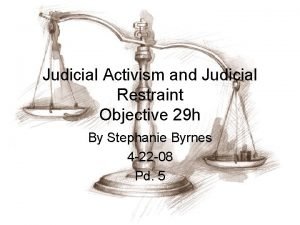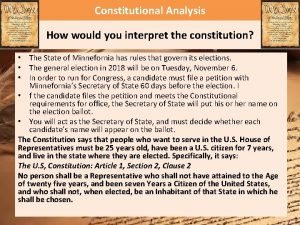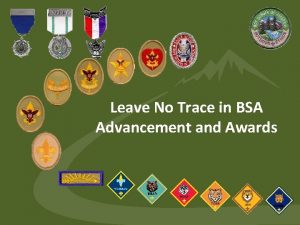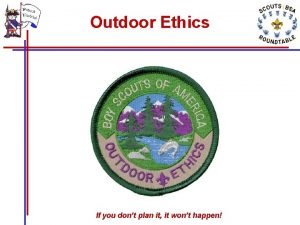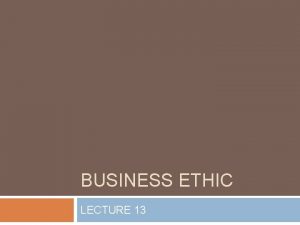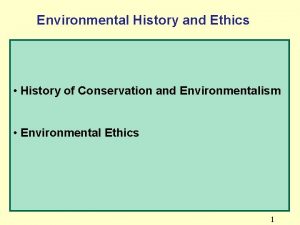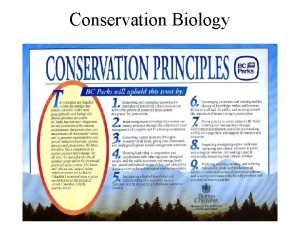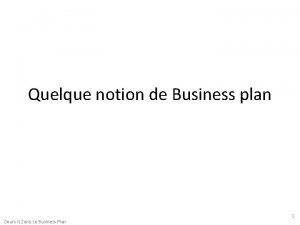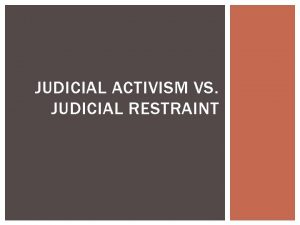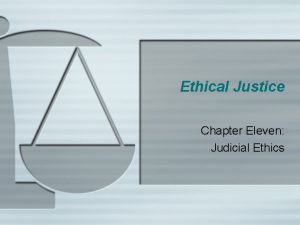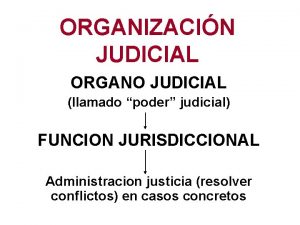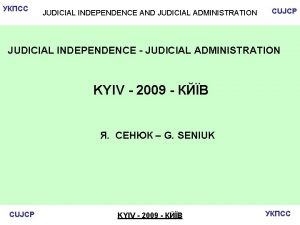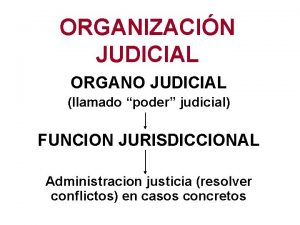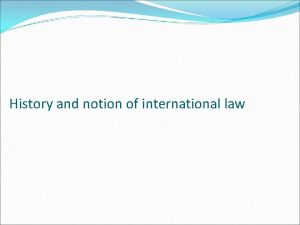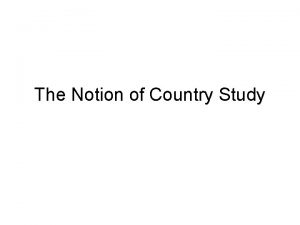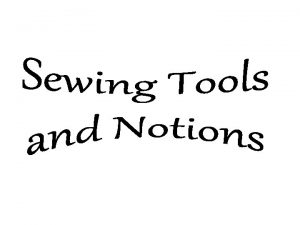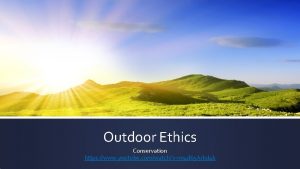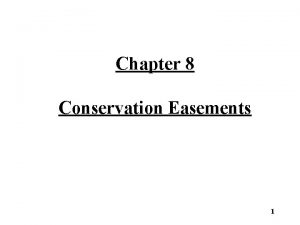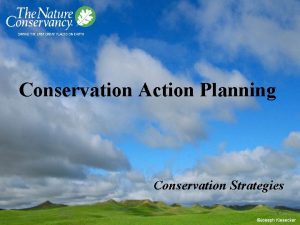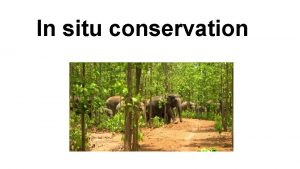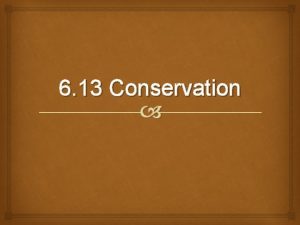Outdoor Ethics Conservation Ethics Judicial notion of good



















- Slides: 19

Outdoor Ethics Conservation

Ethics ▪ Judicial notion of good and bad practices ▪ What someone will do when know one is looking ▪ Governs our personal and group decisions on how we behave in our interactions with the natural world ▪ View of outdoor ethics is changing over time from a perspective of consumption to one of preservation ▪ Outdoor practices from years ago may be disputed as unacceptable in outdoor recreation today ▪ Increased disappearance of natural settings, increased abuse and misuse of nature due to ignorant recreational practices

Conservation • Protection, preservation or restoration of the natural environment, natural ecosystems, habitats, and wildlife • Making life more sustainable for the planet • Avoiding or minimizing negative impacts on the planet by humans • Preserving nature for future generations

History of the Conservation Movement ▪ Began in 1890 ▪ Progressive Era – progressives favored protecting the environment ▪ Writings by Thoreau, Muir, Wesley, Pinchot and other influential people convinced Americans of the importance to the nation of preserving land, water, and wildlife ▪ As cities became crowded, people took up outdoor recreation to escape the crowds of the cities: camping, bird watching, fishing, hunting, etc. ▪ Americans began to value wilderness areas for more than just hunting, logging, and farming

Teddy Roosevelt – “conservationist president” ▪ “We have become great because of the lavish use of our resources. But the time has come to inquire seriously what will happen when our forests are gone, when the coal, the iron, the oil, and the gas are exhausted, when the soils have still further impoverished and washed into the streams, polluting the rivers, denuding the fields and obstructing navigation. ” ▪ As president 1901 -1909 ▪ Created United States Forest Service ▪ Protected nearly 230 million acres of public land ▪ Helped grow the National Park System which later became the National Park Service in 1916

Influential Conservationist – John Muir ▪ Father of the Convservation movement ▪ Conveyed his ideas to the public through writings published in magazines and public speaking ▪ Most famous for writings of Yosemite ▪ Known as an inventor, botanist, self-taught genius, Wildman of the wilderness ▪ Influenced Teddy Roosevelt’s national park plan while camping for 3 days in Yosemite ▪ “Everybody needs beauty. . . places to play and pray in, where Nature may heal and cheer and give strength to body and soul alike, ” wrote Muir (c. 1902). (Corbis) ▪ Helped establish Yosemite National Park and Sequoia National Park ▪ Lifelong legacy was instrumental in strengthening the National Park Service ▪ Founded the Sierra Club

Modern Conservation ▪ After WWII ▪ Newly acquired affluence of Americans made them unwilling to accept environmental degradation in the name of progress ▪ Continued effort to preserve, conserve resources and wilderness as well as improve the urban environment ▪ Make the world production efficient and sustainable ▪ Closely linked with Environmentalism – consumer oriented effort to improve quality of life

Conservation Organizations ▪ The Nature Conservancy ▪ World Wildlife Fund ▪ Natural Resources Defense Council ▪ The Sierra Club ▪ International Crane Foundation

Title and Content Layout with Chart 6 5 4 3 2 1 0 Category 1 Category 2 Series 1 Category 3 Series 2 Series 3 Category 4

Two Content Layout with Table ▪ First bullet point here ▪ Second bullet point here ▪ Third bullet point here Group 1 Group 2 Class 1 82 95 Class 2 76 88 Class 3 84 90

Task description Step 4 Title Task description Step 3 Title Task description Step 2 Title Task description Step 1 Title and Content Layout with Smart. Art








 Judicial activism vs judicial restraint
Judicial activism vs judicial restraint Judicial restraint vs judicial activism
Judicial restraint vs judicial activism Judicial activism vs judicial restraint
Judicial activism vs judicial restraint Judicial restraint vs judicial activism
Judicial restraint vs judicial activism Judicial activism
Judicial activism Leave no trace awareness award
Leave no trace awareness award Leave no trace principles cub scouts
Leave no trace principles cub scouts Bsa outdoor ethics guide
Bsa outdoor ethics guide Ethics is personal myth
Ethics is personal myth Zoroastrianism good thoughts good words good deeds
Zoroastrianism good thoughts good words good deeds Tom hello good morning
Tom hello good morning Cómo se dice buenas tardes
Cómo se dice buenas tardes You are good you are good when there's nothing good in me
You are good you are good when there's nothing good in me Buenas tardes
Buenas tardes Conservation ethics
Conservation ethics Romantic transcendental conservation ethic
Romantic transcendental conservation ethic Resource conservation ethic definition
Resource conservation ethic definition Conservation ethics ppt
Conservation ethics ppt Notion trial
Notion trial Business plan cours
Business plan cours
